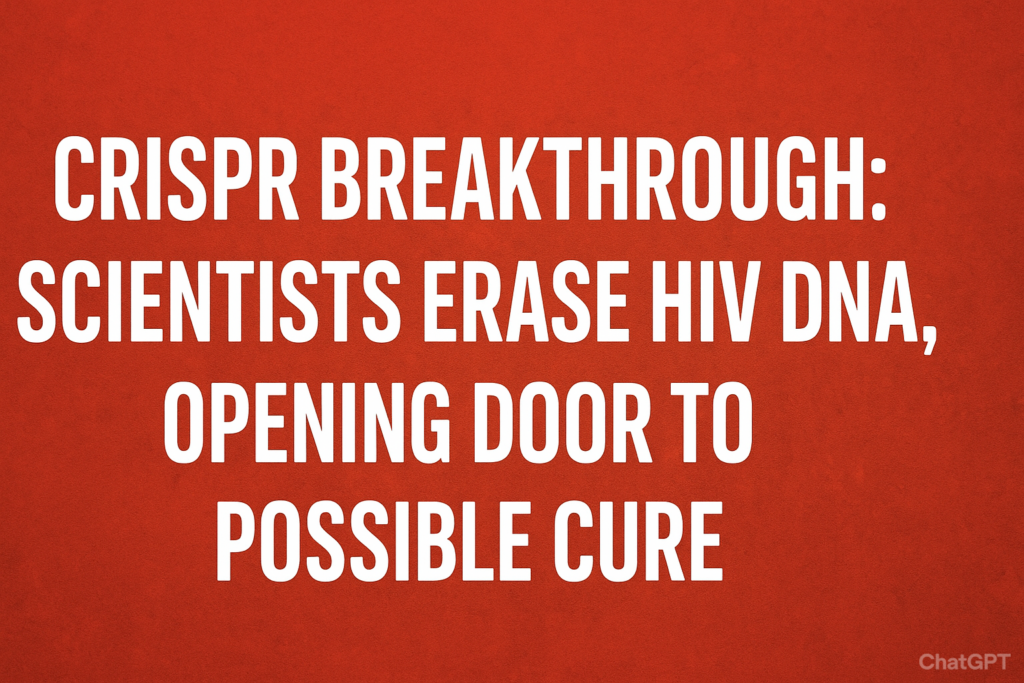Major Takeaways:
CRISPR therapy successfully erased HIV DNA from infected human cells in lab studies.
Treated cells showed no viral rebound, signaling the potential for a permanent cure.
More testing and clinical trials are required before human use.
CRISPR Breakthrough: Scientists Erase HIV DNA, Opening Door to Possible Cure
For decades, HIV has been one of the toughest battles in modern medicine. Communities around the globe especially Black and Brown neighborhoods in America have carried the weight of this epidemic for generations. Now, a new medical advancement may finally shift the fight: a CRISPR Breakthrough that has scientists talking about the possibility of a real cure.
What Exactly Is This Breakthrough?
Researchers recently announced they’ve developed a therapy using CRISPR a powerful gene-editing tool that acts like molecular scissors to cut HIV DNA out of infected human cells. In simpler terms, they’re not just suppressing the virus like today’s medications do. They’re targeting HIV at its root, deleting the genetic instructions that allow it to survive and multiply.
In lab studies, once CRISPR erased the virus from the cells, it didn’t come back. No rebound. No restart. That’s a major difference from antiretroviral therapy (ART), which has been the standard treatment for years but requires daily pills and lifelong management.
This CRISPR Breakthrough suggests a future where HIV might be treated once permanently.
Why This Matters for Urban Communities
HIV has never been just a medical issue it’s been a social, cultural, and economic one too. Urban communities, particularly Black communities, have long been hit harder by the virus due to limited access to healthcare, stigma, and systemic inequalities.
In cities like Jackson, Mississippi, and Las Vegas — places where Urban City readers call home HIV remains a very real challenge. A treatment that doesn’t just suppress but potentially erases HIV could be transformative. Imagine an entire generation freed from the burden of daily pills, stigma, and the constant fear of transmission. That’s not just medicine; that’s liberation.
How CRISPR Works
CRISPR stands for “Clustered Regularly Interspaced Short Palindromic Repeats” yeah, it’s a mouthful. But what matters is how it works: scientists can program CRISPR to recognize specific DNA sequences, then cut them out like a bad sentence in a script.
For HIV, that means locating the virus’s DNA hiding inside human cells, snipping it out, and leaving the cell healthy and infection-free. The most groundbreaking part? Once the cut is made, the virus can’t replicate. That’s like pulling the battery out of a device it simply shuts down.
The Road Ahead
As exciting as this sounds, let’s keep it real: this isn’t available at your local clinic tomorrow. The studies so far have only been done in labs. Clinical trials the stage where therapies are tested in people are still needed to make sure the treatment is safe and effective for humans.
Researchers are optimistic, though, and early results are generating major buzz in the medical community. If the trials go well, this CRISPR Breakthrough could eventually change the way HIV is treated worldwide.
A Turning Point in the HIV Fight
For over 40 years, HIV has been one of the world’s most persistent and devastating epidemics. It has claimed millions of lives and continues to impact marginalized communities disproportionately. While antiretroviral drugs have turned HIV from a death sentence into a manageable condition, they never offered a true cure.
This new approach could mark the first step toward ending the epidemic entirely. A one-time treatment with lasting effects could shift the narrative from survival to complete healing.
What This Means for the Future
For Urban City readers, the message is clear: science is finally catching up to what the community has always needed not just treatment, but a way out. If this research delivers on its promise, it could bring hope to families, cut healthcare costs, and ease decades of trauma connected to HIV/AIDS.
Of course, it will take time, money, and continued focus to bring this therapy from lab studies to real-world clinics. But one thing’s for sure: the CRISPR Breakthrough has people reimagining a world where HIV isn’t just controlled it’s cured.














